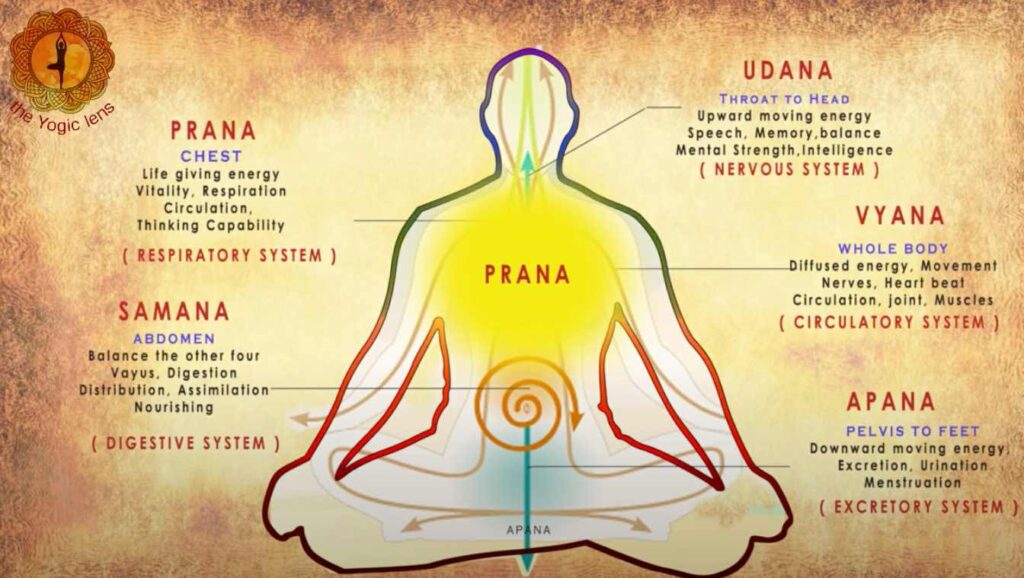The Vital “Winds”-Vayus

In the last Yoga Sutra Discussion Group we discussed three more sutras in the third chapter regarding yogic powers that relate to integration of the energetic “winds” called the vayus and the elements of earth, water, and fire.
Yoga Sutra III.39 (depending on the translation, sometimes III.38) has to do with entering another’s body at will. Though quite a controversial idea for those of us still very attached to our own physical earthly body, there are a myriad of stories in Indian mythology and culture that refer to this very power. In I.K. Taimni’s translation, “The Science of Yoga”, he reminds us that we regularly might borrow a friend’s car or house-sit in a friends house, and our body’s are just made of the same stuff. If done with permission and correct knowledge, the pure consciousness can leave the confines of the body and be free to roam. This is not done on a whim or for nefarious purposes. We must also remember the previous sutra warning of the powers becoming actual impediments to further growth in yoga, not to mention the practice of the entire 8 limbs of yoga that bring us to this point of wisdom and knowledge of the Self.
The next two sutras have to do directly with integration of the udana vayu (III.40) – the vital energy that has to do with raising energy from lower spine to brain and helps us rise against gravity- and the samana vayu (III.41)- the vital energy that stokes the gastric fire. With samyama (integration) of the udana vayu, a yogi is said to be able to walk on water and move easily over obstacles without touching (levitation). With samyama of the samana vayu, the yogi is said to glow like fire with a shining aura.
The other “vital energetic winds”, vayus, that are not mentioned within these sutras are apana (the energy that regulates the out breath and elimination, relating to the lower abdomen), prana (the energy that regulates in breath and inspiration and resides within the chest area), and vyana (the circulatory factor that unites all the other vayus together within the entire body structure). All are important connections to the nadi and chakra systems that also carry pranic energy throughout the body and throughout life.
As we have with the other “naturally super” powers of yoga (vibhutis), we discussed and attempted to connect these more esoteric powers to more practical experiences we have had in our practices of yoga asana and pranayama. We may not yet levitate, but the elements and vayus show up in our experiences of lightness and heaviness, space or contraction, heat or cold. And though we may not direct our own energy and consciousness into another’s body at will, we may at least feel a hint of freedom in the movement of consciousness beyond the physical body in our full surrendered Savasana (corpse pose). We also know when we have met people who are focused and serene, how they “shine” and we are drawn to their energy and their “glow” of peacefulness.
The next three sutras we will discuss continue within the realm of conquering and integrating fully with the elements of nature and also deals with an even more bodiless state of consciousness. Below translations are from BKS Iyengar’s Light on the Yoga Sutras of Patanajali:
III.42 : By samyama (integration) on the relation between space and sound, the yogi acquires the power of hearing distant and divine sounds.
III.43 : By knowing the relationship between the body and ether, the yogi transforms his body and mind so that they become as light as cotton fibre.
III.44 : By samyama (integration) on the disembodied state, where consciousness acts outside the body, the veil covering the light of illumination is destroyed.
Our Yoga Sutra Discussion Group meets the FIRST SUNDAY of EVERY MONTH and our next meeting will be May 1 at 11:00am CST via Zoom. ALL are welcome and participation is FREE! You just have to register to get the link to attend. All discussions stand alone, with recaps of any pertinent information or discussion, so please feel free to join in any time.
Contemplations for the next discussion:
- How well do you listen to others and how well do you listen to your own self? What would be your impression of “divine sound”?
- What is/are your natural elemental tendency/ies? Earth, water, air, fire, or ether? Do you seek a balance in your yoga practice or do you feed into your natural tendency/ies more often?
- What poses are “grounding” and what poses are “lightening”? What poses build heat and what poses cool?
- Has the practice of yoga brought you more insight into your own space or self-knowledge? In what ways?
- Can you imagine a state of consciousness free of ego, ignorance, or delusion? What does that mean to you?